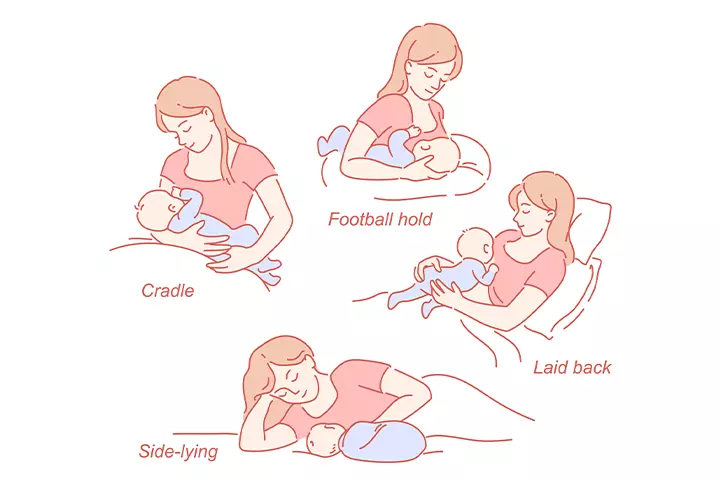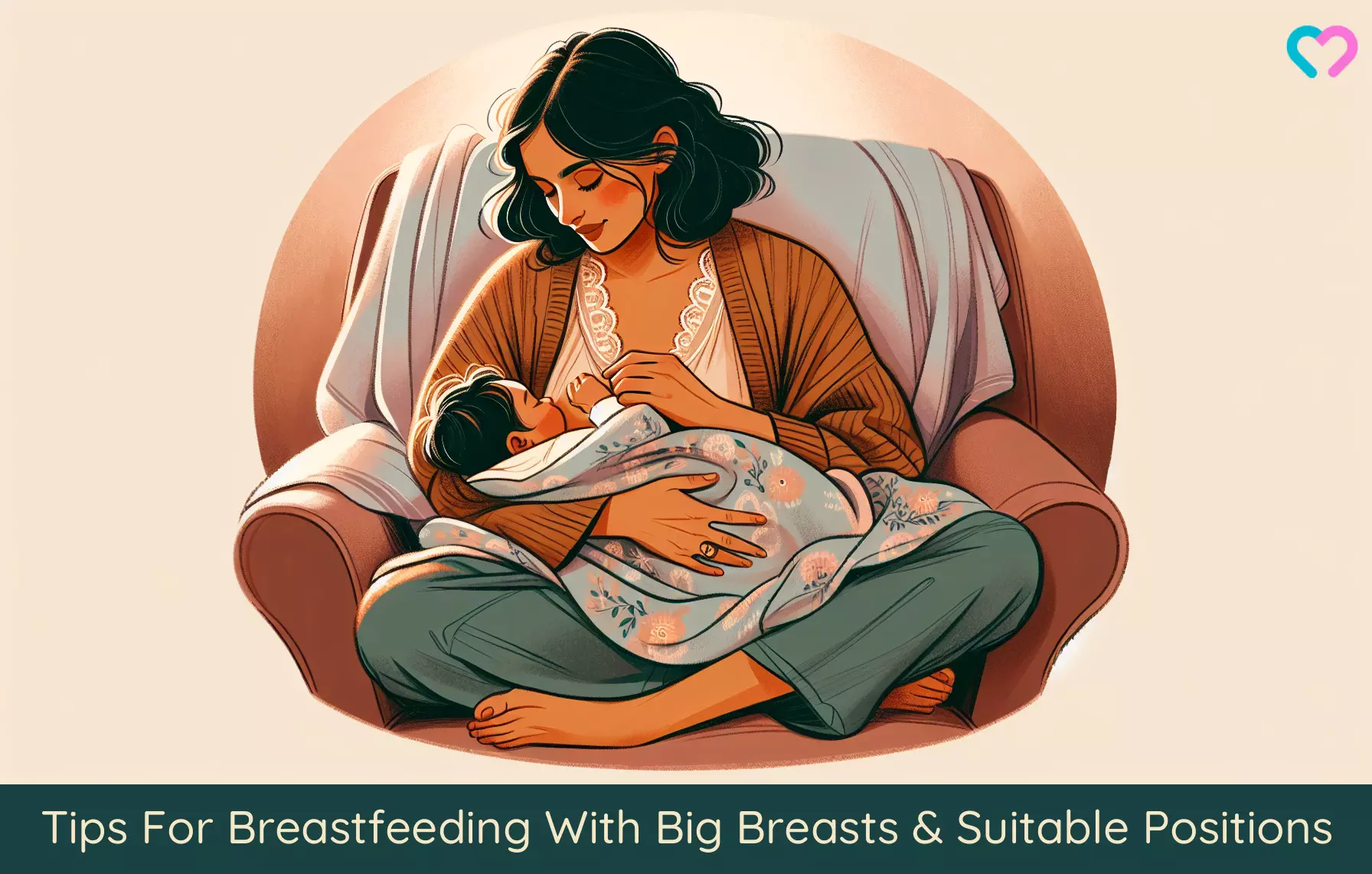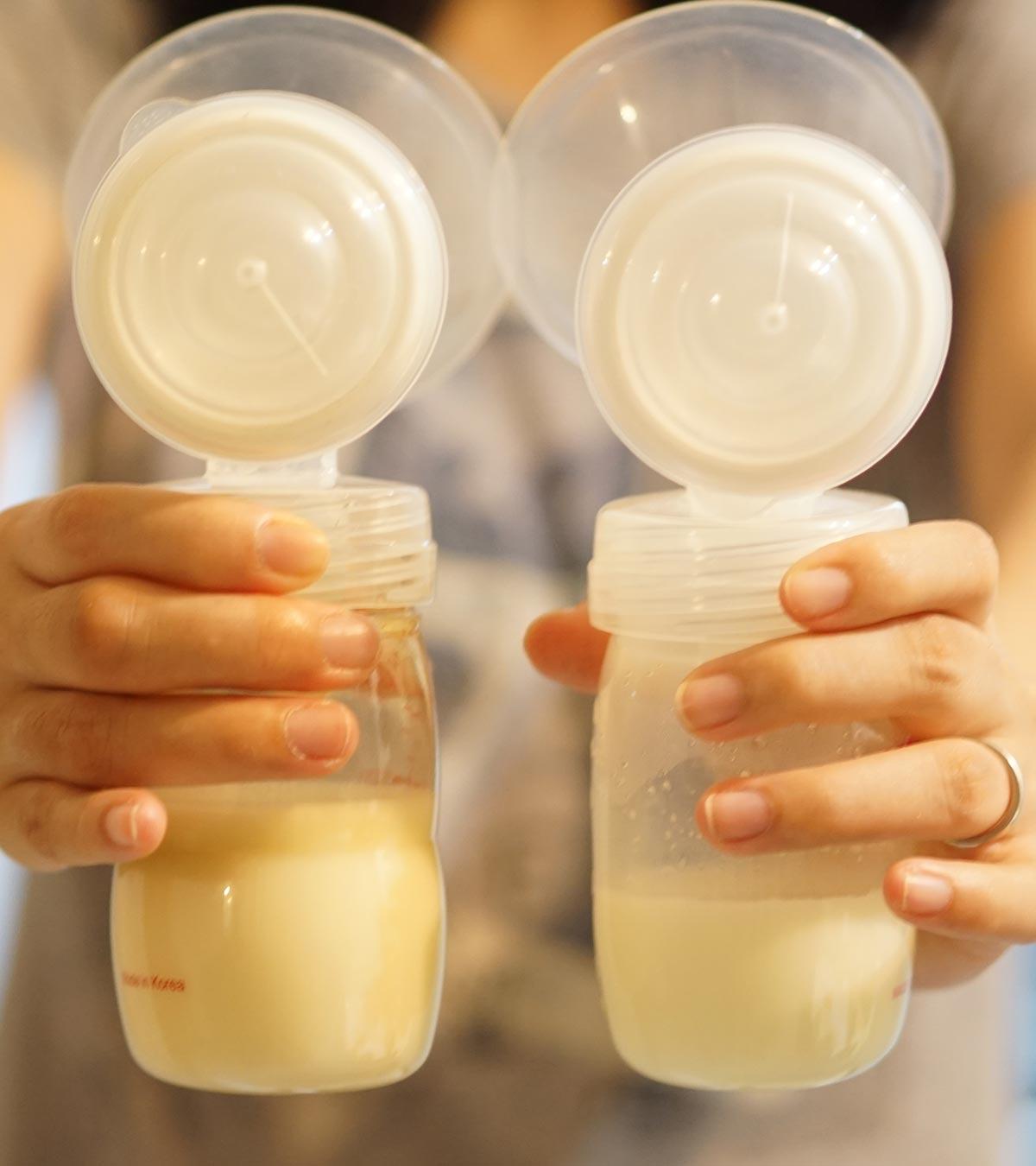
Image: Shutterstock
Breastfeeding works the same for all women, irrespective of the size and shape of their breasts. However, breastfeeding with big breasts may lead to some challenges with position and latching, in addition to the other challenges of breastfeeding. Some tips and tricks can help women with heavy breasts have a successful breastfeeding journey.
If you are a breastfeeding mother experiencing challenges due to larger breasts, this post can help you with some tips and answer your queries regarding positioning and latching.
Key Pointers
- Mothers with large breasts may be worried about their baby suffocating under their breasts.
- Larger breasts can lead to incorrect latch, neck pain, back pain, rashes under the breast, etc.
- Cradle hold, laid-back feeding, football hold, and side-lying feeding are a few positions that may be comfortable for women.
What Are The Challenges Of Breastfeeding With Big Breasts?
Mothers with big breasts may face some or all of the following issues while breastfeeding with large breasts (1).
- Mothers may be worried about their baby getting trapped or suffocated under their large breasts. They might also fear that the baby’s nose might get pinched under the large breasts. However, maintaining a proper breastfeeding position and a good hold can help you overcome this problem.
- Due to the more weight of larger breasts, they hang lower, and hence it might make a mother bend forward and give the nipple in the baby’s mouth. It leads to poor back and neck posture, leading to back and neck pain.
- A good latch requires a baby to take the entire areola along with the nipple in the mouth. In women with larger breasts, the areola is also large, and as a result, the baby may not be able to take the entire areola in the mouth. It can cause incorrect latch and associated issues in babies and mothers.
- Mothers may develop rashes under their breasts due to the larger size of the breasts.
Image: IStock
- The mother may not be able to see the baby quite well due to obstruction by large breasts. They might also not know the correct position of the nipple in the baby’s mouth or whether they are properly latched to the breast, which could lead to unfulfilled needs or inadequate feeding.
- Apart from these, they may also face the other issues that all lactating mothers face, such as engorgement, cracked and sore nipples, clogged milk ducts, mastitis, and thrush. You may read more about common breastfeeding problems here.
Does Having Larger Breasts Mean A Higher Milk Supply?
A woman’s breasts or mammary glands are made of fatty tissue, glandular tissue, and connective tissue. The glandular tissue in the breast is responsible for milk production. Larger breasts mean more fatty tissue in the breasts. Therefore, the size of a woman’s breast does not have any impact on milk production (2). Research also states that overweight or obese mothers, who usually may have larger breasts, may produce less milk due to unhealthy body weight (3).
 Did you know?
Did you know?Easier Breastfeeding Positions For Women With Larger Breasts
While the best breastfeeding position is the one that the mother finds the best, the following breastfeeding positions are found more comfortable by women with larger breasts (4)
(5).
Image: IStock
1. Rugby or football hold
- It is also called a side-sitting hold or clutch hold. The baby’s head is placed close to the side of the breast from which the baby will feed.
- The mother tucks the baby’s body against her side and under her arm.
- The mother’s forearm will support the baby’s upper back, and her hand and fingers will support the baby’s shoulder, neck, and head.
- The baby’s legs will stretch out straight behind you.
- If the mother is on a chair. The baby’s bottom can be rested against the back of the chair, and the legs can be angled straight up.
- The mother may keep a pillow under the elbow for support. The pillow can also keep the baby’s head at the same level as the mother’s breast.
- It is beneficial for a mother with larger breasts because she can see both her nipple and the baby’s mouth.
2. Side-lying position
- The mother lies on the side with pillows behind her back and under her head.
- The mother should keep her back and hips in a straight line.
- The baby should be kept in a straight parallel line to the mother’s body in a way that the baby’s mouth faces the mother’s nipple.
- The mother’s arm should be around the baby.
- The other hand may be used to support the breast to aid in a better latch.
- This position is helpful as the mattress supports the weight of the mother’s breast.
- The mother can feed the baby from both sides without changing sides by elevating the baby with a pillow.
- You may also use a table to mimic the side-lying breastfeeding position while sitting. The table will take the weight of both the mother and the baby.
3. Laidback breastfeeding
- The mother sits in a semi-reclined position on a chair. The mother may use a small pillow under the lower back for better support.
- In this position, the entire weight of the baby’s body is taken by the mother’s body as the baby lies on top of the mother’s stomach.
- The baby and the mother are in skin-to-skin contact all the time.
- The benefit of the laidback breastfeeding position is that the breast tissue flattens a little when the mother is in a semi-reclined position, keeping the breast tissue away from the baby’s nose.
- In this position, the weight of the breasts is away from the baby’s body.
- This position is also known as the Australian or the down-under position.
 Quick fact
Quick fact4. Cradle hold
- This is the traditional breastfeeding position.
- The mother supports the baby on the arm that is on the same side as that of the breast that is being used.
- The baby’s head rests on the inner surface of the mother’s elbow, the mother’s forearm supports the baby’s back, and the palm is used to hold the baby’s buttocks or upper thighs.
- You can use the other hand to support the breast or the nipple.
- In this position, the lap or tummy will take the weight of the mother’s breasts.
Tips For Breastfeeding With Large Breasts
The following tips could help you make your breastfeeding journey smoother (2).
- A little knowledge about breastfeeding positions and techniques can help you embark on a smooth breastfeeding journey sooner. If you are a first-time mother, having a little information in advance can help you and your baby. Consult your obstetrician, midwife, or lactation consultant to guide you about breastfeeding.
- Larger breasts filled with milk may get too heavy, and a well-supportive nursing bra might help prevent back and neck pain.
Image: IStock
- You may use a feeding pillow to prop the baby up so that you can see where and how they latch.
- You may use a rolled-up cloth nappy or a bunny rug under the breast to prop the breast up. It will help you view the baby’s mouth properly and also keep your breast from falling onto the baby’s nose.
- You can use the C-hold to grasp your breast while you are latching the baby on. It makes latching easier for the baby. The following are the steps to achieve the C-hold.
- Place your breast in the palm of your hand.
- Put your thumb on the top of your breast and use your fingers to cup your breast.
- The hand should look like the letter “C.”
- Keep your thumb and fingers around the areola so that the entire areola is available for the baby to latch on.
- The C-hold will help you direct the nipple and areola well into the baby’s mouth.
- You may choose to breastfeed your baby in front of a mirror. It will help you view your and your baby’s position well and keep an eye on the baby’s latch.
- Keep the baby’s chin well attached to the breast. It will keep the nose clear from the breast tissue.
- Always keep the baby and your breast at the same level.
- If your breasts are full and engorged, it might be more difficult to feed the baby. Hand-expressing or pumping excess milk would be able to relieve the engorgement. Latching will be easier for babies if the breasts are softer.
- Monitor your baby’s weight regularly to check if they are feeding and growing well and that they are not gaining weight too quickly.
- Due to sweat and leakage of breast milk, rashes might develop under the breasts. The dampness may be a breeding ground for yeast and dermatitis. Keep the area clean, dry, and expose it to air for as long as you can.
Can You Breastfeed If You Had A Breast Cosmetic Surgery?
Image: Shutterstock
Most women can breastfeed even if they had a breast reduction or a breast augmentation surgery in the past. During breast augmentation surgery, breast implants are placed between the chest wall and the breast. It does not impact or interfere with the functions of the breast ducts. In breast reduction, a part of the glandular tissue is removed, but, in most cases, there is enough tissue left to produce breast milk.
In a few women, the breast milk supply might be hampered due to surgical incisions or damage to the nerves of the breast during the procedure. Your surgeon, gynecologist, or lactation consultant can help you with breastfeeding after breast surgery and suggest relevant interventions to help you meet your baby’s needs (6).
Frequently Asked Questions
1. How can I breastfeed if my nipples are flat?
Start nursing before your milk has fully accumulated. It is simpler for your baby to latch on and nurse at this time since your breasts are softer. Before feeding, you can stimulate the nipple by using a pump, rolling it between your thumb and index finger, or applying a cool washcloth. These methods will help bring the nipple out more and make latching simpler. Pull your breast tissue inward and toward your body to help push your nipple out. However, you can see a doctor or lactation consultant for assistance (9).
2. How can I prevent my breasts from sagging after breastfeeding?
You can prevent your breasts from sagging by weaning your baby gradually, wearing a proper-fitting and supportive bra, abstaining from smoking, starting to lose weight gradually, eating a balanced diet rich in whole grains and fruits, applying a mild moisturizer to your breasts, maintaining good posture while breastfeeding, and drinking plenty of water (10) (11).
3. Should I use a larger-sized nipple shield if I have large breasts?
A large-sized nipple shield helps the effective transfer of milk to the baby and may be used irrespective of the nipple size (12). However, you may consult your lactation specialist before choosing a nipple shield for better guidance.
4. Is it normal for my baby to gag or choke while breastfeeding from a large breast?
Gagging or choking during breastfeeding is a common symptom of spitting up reflux in babies and may also occur from an oversupply of milk (13) (14). However, breast size is not related to the volume of milk produced (15), and thus a baby may gag or choke during breastfeeding irrespective of the breast size.
5. What should I do if I feel uncomfortable breastfeeding in public?
If you feel uncomfortable breastfeeding in public, try practicing at home to build confidence. Wear clothes that make nursing easier, and use a nursing cover if it helps you feel more private. Look for quiet or family-friendly spots, and consider having a friend or family member accompany you for extra support and reassurance.
Breastfeeding with big breasts is possible because the size of the breast does not affect its ability to produce milk. However, women with larger breasts may experience some discomfort while nursing their babies. Besides, they may have body image issues, which could affect their confidence and self-esteem. Further, they may worry about their baby being suffocated by the size of the breasts, experience back and neck pain, and notice an improper latch. To avoid these difficulties, adopt the right feeding positions, such as the football, side-lying, or cradle holds. You may also prop the breast up with a rolled cloth or place your palm under the breast to support it while feeding. If you face other problems, visit a lactation consultant for guidance.
Infographic: Breastfeeding Advice For Women With Larger Breasts
Although having larger breasts does not mean an increased breast milk supply, it surely comes with various breastfeeding challenges, such as difficulty positioning the baby for nursing. Read through the infographic below to learn about some helpful suggestions to overcome these breastfeeding challenges.
Illustration: Momjunction Design Team
Illustration: Tips For Breastfeeding With Big Breasts & Suitable Positions
Image: Dall·E/MomJunction Design Team
Learn how to breastfeed with large breasts! Get tips and tricks to make it easier and more comfortable for you and your baby.
References
1. Breastfeeding Tips for Women with Large Breasts;International Lactation Consultant Association
2. Breastfeeding with large breasts;The Australian Breastfeeding Association
3. Do Larger Breasts Make More Milk?;International Milk Genomics Consortium
4. Breastfeeding With Large Breasts;Breastfeeding Support
5. Positions For Breastfeeding;American Academy of Pediatrics
6. Think You Can’t Breastfeed After Implants? Think Again; The Johns Hopkins University
7. Halil Türkan et al.; (2016);Gestational Gigantomastia ; NCBI
8. Nursing positions; Nemours Children’s Health
9. Flat Nipples; Cleveland Clinic
10. Physical changes and concerns; South Dakota Department of Health
11. 6 causes of breast sagging; Piedmont
12. Nipple Shields; The Royal Women’s Hospital
13. Breastfeeding challenges; NHS UK
14. Oversupply; La Leche League International
15. J K Renner et al.; (2004); The Relationship between Breast Size and Breast Milk Volume of Nursing Primipara; Nigerian Quarterly Journals of Hospital Medicine
Community Experiences
Join the conversation and become a part of our nurturing community! Share your stories, experiences, and insights to connect with fellow parents.
Read full bio of Dr. Dur Afshar Agha
Read full bio of Dr. Ritika Shah
Read full bio of Swati Patwal
Read full bio of Ghazia Shah



























